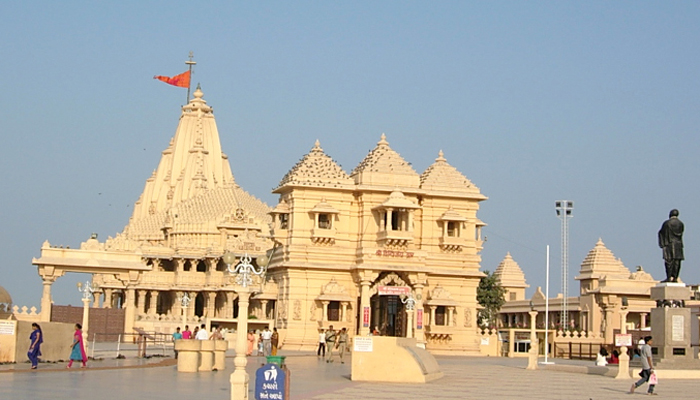Somnath Temple is a significant temple, comprising one of the twelve Jyotirlingas of Lord Shiva. Located in Prabhas Kshetra near Veraval, Somnath Mandir falls in Saurashtra region that lies on the western coast of Gujarat. The temple of Somnath can be easily reached from anywhere in Gujarat. Bus services to Somnath are available from all the cities and towns of Gujarat. To ensure a comfortable journey, one can also opt for taxis that can be hired throughout the state of Gujarat.
Somnath Temple stands as a symbol of rich cultural heritage of India. The mention of this ancient temple has been made in the scriptures like 'Rig Veda' of the Hindu origin. The term Somnath suggests 'the protector of Moon God'. Lord Shiva is depicted here in the form of a Jyotirlinga (linga of light), as the protector. The incredible temple of Somnath is called as 'the Shrine Eternal' since, the temple has been shattered for not less than six times and every time, it has been reconstructed.
Legend
Somnath Temple has a legend behind its establishment. It is believed that Lord Chandra (Moon God) was very proud of his beauty. Due to this reason, he was cursed by his father-in-law Daksha, to get smaller. In order to get rid of this curse, Moon God prayed to Lord Shiva at Prabhas. Lord Shiva became happy with the penance of the Moon and reduced the curse to an extent. This incident led to the periodic waning of moon.
History
Maintaining the original site, the present temple is said to have built for the seventh time. The first temple of Somnath is regarded as a structure in Gold, made by Moon God himself. In the 7th century, Somnath Temple was reconstructed by Maitraka kings of Vallabhi in Gujarat. The second structure was destroyed by the Arab governor of Sind by the name of Junayad in 725. Again in 815, the third structure was built by Nagabhata II, who was a Pratihara King.
This structure was erected out of red sandstone. In 1024, the temple was raided by Mahmud Ghazni, who took camel-loads of jewels and valuables from here. The Paramara King Bhoj of Malwa and the Solanki King Bhima of Gujarat (Anhilwara) took the initiative to rebuild the temple during 1026-1042. For the fifth time, the wooden structure was replaced with a stone structure by Kumarpal.
Consequently, the temple was destroyed in 1297 by the Sutanat of Delhi and once again in 1394. The last attack was made by the Mughal Emperor, Aurangzeb in 1706. The present temple was built in 1995 by Shree Somnath Trust in the company of the Government of India. Today, Somnath Temple is under the maintenance of Shree Somnath Trust.
Architecture
The seven-storied structure of Somnath is tall to 155 feet. Constructed in the Chalukya style of architecture, Somnath Temple reflects the expertise of the Sompuras that are master masons of Gujarat. The temple is sited in such a manner that no mass of land can be seen from Somnath seashore till Antarctica. This information is presented in an inscription, written in Sanskrit, on the Arrow-Pillar of the sea-protection wall at the temple.
In the words of Dr. Rajendra Prasad (the first president of India), "Somnath Temple signifies that the power of creation is always greater than the power of destruction". The great history and religious importance of Somnath temple attracts pilgrims as well as tourists from India and abroad.
Location : In Prabhas Kshetra near Veraval in Saurashtra, Gujarat
Dedicated to : Lord Shiva
Significance : One of the 12 Jyotirlingas of Lord Shiva

